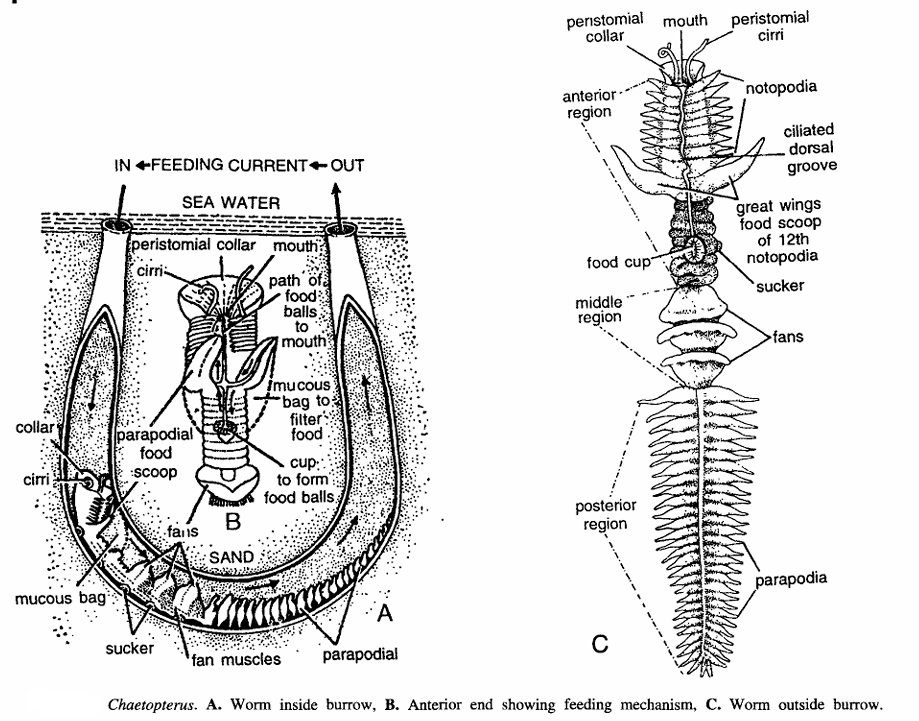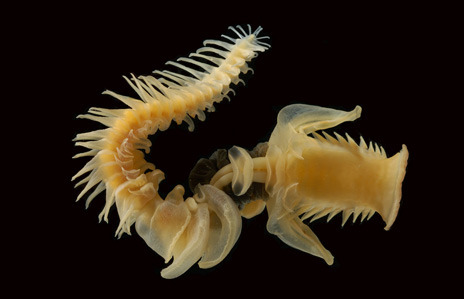Chaetopterus: The Parchment Worm – Morphology, Classification, Habitat, and Ecological Role
Chaetopterus, commonly known as the parchment worm or parchment tube worm, is a genus of marine polychaete annelids renowned for their unique tube-dwelling behavior and distinctive parchment-like tubes they construct in sedimentary marine environments. These worms display remarkable adaptations for filter feeding, burrowing, and bioengineering their habitats. Their biological and ecological features offer insight into benthic marine ecosystems’ complexity and sediment dynamics. Known for their pale translucent bodies and large parchment tubes, Chaetopterus species are a unique component of many marine habitats worldwide.
Classification of Chaetopterus
| Taxonomic Rank | Name | Characteristics |
|---|---|---|
| Kingdom | Animalia | Multicellular organisms with specialized tissues |
| Phylum | Annelida | Segmented worms with true coelom and segmented bodies |
| Class | Polychaeta | Bristle worms with paired appendages (parapodia) |
| Order | Sedentaria | Sedentary marine worms with tubes or burrows |
| Family | Chaetopteridae | Tube-dwelling polychaetes with parchment-like tubes |
| Genus | Chaetopterus | Marine worms that build U-shaped parchment tubes in sediments |

Habit and Habitat
Chaetopterus worms inhabit sandy or muddy substrates in shallow coastal to moderate depths, sometimes extending to much deeper waters. They build characteristic U-shaped parchment-like tubes buried in sediment or attached to hard substrates such as rocks or coral. The tubes are flexible yet strong, protecting the worm and aiding water circulation for respirational and feeding purposes. Within the tubes, the worms remain mostly stationary, employing filter feeding via mucus nets to collect plankton and organic particles from the water.
Juvenile Chaetopterus are planktonic, adding to their dispersal and colonization capabilities. Their tubes often extend above the sediment surface, terminating in chimneys that facilitate water flow and particle capture. These burrowing activities also aerate sediments, playing a vital role in benthic ecosystem health.

General Characteristics
- Commonly called as paddel worm having greatly modified segments.
- Tube is opaque, measuring approximately 50 cm long and about 1 cm in diameter.
- Body is white, delicate, 30 cm long and divided into anterior, middle and posterior regions.
- The tentacles and palps are absent except a pair of backwardly directed peristomial cirri.
- Parapodia are variously modified as for water pumping fans, sucking discs or food ball organs.
- Anterior region comprises of 15 to 20 segments, having a funnel-shaped mouth surrounded by a collar-like peristomium and a pair of peristomial cirri in the first segment.
- Rest of the segments have reduced notopodium. Tenth segment bears great aliform wings like notopodia which collect food.
- Middle region has fused segments. The notopodia of segments 14 to 16 are fused in mid line to form three fans. Notopodia are fused to form suckers.
- Posterior region is longer with a pair of parapodia in each segment, about 11 to 30 in number.
- Body Shape: Elongate and cylindrical, usually pale or translucent with some species exhibiting subtle pigmentation.
- Size: Adults can reach up to 25 cm or more in length and 1–2.5 cm in diameter.
- Segments: Body divided into three regions – anterior with the head, a mid-regional section with specialized parapodia for feeding, and a posterior region with uniform segments.
- Tube: Constructed of mucus and sediment-bound parchment material, the tube provides shelter and feeding efficiency.
- Feeding structures: Modified parapodia develop into ciliated fan-like structures to generate water currents for filter feeding.
- Circulatory system: Includes hemoglobin allowing oxygen transport in sedimentary environments.
- Sensory organs: Include small antennae and palps on the head; eyes are rudimentary or absent.
- Reproductive system: Typically separate sexes with external spawning.
Special Features
- Tube Construction: The parchment tubes can grow up to 85 cm in length with vertical chimneys protruding above the sediment surface, essential for ventilation and particle collection.
- Filter Feeding: Unique feeding mode employing mucus nets and ciliary currents that maximize plankton and detritus capture.
- Bioengineering: The burrowing and tube-building activities modify sediment structure, promoting biodiversity.
- Regeneration: Chaetopterus can regenerate lost segments, vital in their tube-confined lifestyle.
- Bioluminescence: Several Chaetopterus species possess bioluminescent tissues producing blue-green light when disturbed, thought to deter predators.
- Larval Development: Juvenile stages are planktonic larvae with multiple growth stages before settling.
Identification
Chaetopterus species are identified by:
- Tube morphology and size.
- Segmentation patterns with specialized feeding appendages.
- Unique parapodial structures adapted for filter feeding.
- Adult pigmentation and size.
- Molecular analysis complements morphological characteristics for species-level identification.

Life Cycle and Reproduction
Chaetopterus exhibit sexual reproduction with separate males and females. Spawning is typically synchronized by environmental cues, involving the release of gametes into seawater. Fertilized eggs develop into planktonic trochophore larvae, which undergo several growth stages before settling to the seabed to metamorphose into adults.
Growth from larva to adult and tube construction is essential for survival, with juveniles relying on planktonic feeding before transitioning to tube-dwelling filter feeders. Seasonal variation in reproduction ensures population sustainability and dispersal.
Ecological Role and Importance
- Sediment modification: Tube-building alters sediment properties, improving oxygenation and microhabitats.
- Filter feeding: Controls plankton populations and recycles organic matter.
- Prey and predator: Serve as prey for fish and influence benthic food webs while consuming plankton and detritus.
- Habitat creation: Tubes offer refuges for other invertebrates, increasing biodiversity.
- Research significance: Model organisms for studying benthic ecology, tube-building behavior, and bioluminescence.
Check sources
- https://en.wikipedia.org/wiki/Chaetopterus
- http://www.marinespecies.org/aphia.php?p=taxdetails&id=129914
- https://en.wikipedia.org/wiki/Chaetopterus_pugaporcinus
- https://animaldiversity.org/accounts/Chaetopterus/classification/
- https://www.marlin.ac.uk/species/detail/1681
- https://www.envirolink.govt.nz/assets/Envirolink/2423-MLDC170-Background-information-on-the-parchment-worm-Chaetopterus-sp.-info-sheet.pdf
- https://www.britannica.com/animal/parchment-worm
- https://www.inaturalist.org/taxa/171303-Chaetopterus
- http://www.marinespecies.org/aphia.php?p=taxdetails&id=129229
- https://www.inaturalist.org/taxa/216631-Chaetopterus-variopedatus

